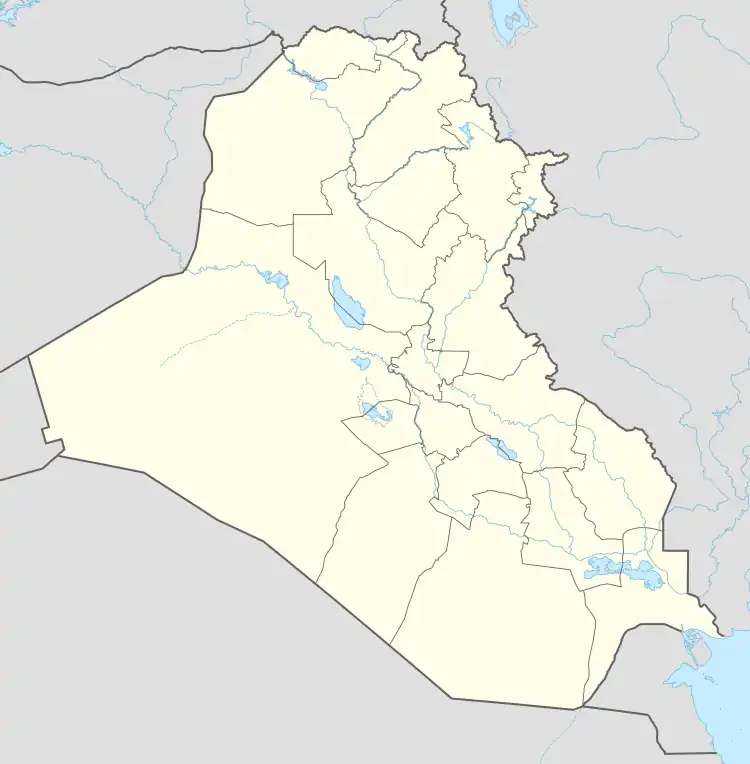Kani Balavi
Kani Balavi[nb 1] (Arabic: كاني بلافي[4] or كاني بلاف,[5] Kurdish: کانی بهلاڤ,[6] Syriac: ܟܢܝ ܒܠܦ̮)[5] is a village in Duhok Governorate in Kurdistan Region, Iraq. It is located in the district of Amadiya and the historical region of Barwari Bala.
Kani Balavi | |
|---|---|
Village | |
 Location in Iraq | |
| Coordinates: 37°10′41.4″N 43°11′07.3″E | |
| Country | |
| Region | |
| Governorate | Dohuk Governorate |
| District | Amadiya District |
| Sub-district | Bamarni |
History
Kani Balavi was inhabited by 20-30 Assyrian families in 1850.[8] After the Assyrian genocide in the First World War, Assyrian refugees from Ashitha in Turkey settled at Kani Balavi, and the village had a population of 110 people by 1933,[7] in which year it was looted and burned by the Iraqi army during the Simele massacre.[9] In 1938, 20 families populated Kani Balavi.[7] The village had a small Jewish community of several families until their departure in 1949.[5][8]
The population increased to 190 Assyrians by the Iraqi census of 1957, and in 1961, there were 70 families in 35 houses.[8] The village's population temporarily fled and took refuge elsewhere during the First Iraqi–Kurdish War in the 1960s, and later returned.[10] Kani Balavi was destroyed by the Iraqi army, and its population forcibly expelled, during the Al-Anfal campaign in 1988.[8]
15 Assyrian families returned and rebuilt Kani Balavi,[10] but it was reported that Kurds from neighbouring villages had illegally seized the village's water sources and constructed houses on villagers' land in 1992.[1] In early 2009, 72 displaced Assyrians, with 19 families, resided at Kani Balavi.[11] By 2011, the Supreme Committee of Christian Affairs had constructed 39 houses, a church, and community hall, and developed the village's infrastructure.[5]
In 2012, it was estimated that 15 Assyrians, all adherents of the Assyrian Church of the East, inhabited Kani Balavi.[12] In August 2014, the Assyrian Church of the East Relief Organisation reported there were 45 displaced Assyrian families in the village,[13] and the Assyrian Aid Society provided humanitarian aid in November.[3] As of 2021, 29 Assyrians inhabit Kani Balavi.[14]
References
Notes
Citations
- "Universal Periodic Review of the State of Iraq: Annex: Table for 94 cases showing the land grab of the Assyrian villages". Assyrian Aid Society. 28 March 2019. Retrieved 7 May 2020.
- Donabed (2015), p. 112.
- Patto, Christina K.; Eskrya, Eramia S. (2014). "Assyrian Aid Society of Iraq: Annual Report 2014" (PDF). Assyrian Aid Society. Retrieved 29 April 2020.
- "قرية كاني بلافي". Ishtar TV. 29 August 2015. Retrieved 15 February 2021.
- "Kani blavi". Ishtar TV. 25 June 2011. Retrieved 11 May 2020.
- KRSO (2009), p. 161.
- Donabed (2015), pp. 323–324.
- Donabed (2010), p. 207.
- Donabed (2010), p. 290.
- Eshoo (2004), p. 5.
- "The Struggle to Exist Part I: An Introduction to the Assyrians and their Human Rights Situation in the New Iraq" (PDF). Assyria Council of Europe. February 2010. p. 33. Retrieved 2 May 2020.
- "Christian Communities in the Kurdistan Region". Iraqi Kurdistan Christianity Project. 2012. Archived from the original on 2020-11-24. Retrieved 14 August 2021.
- "Relief Campaign In Full Force". Assyrian Church of the East Relief Organisation. 8 August 2014. Retrieved 11 May 2020.
- "Population Project". Shlama Foundation. Retrieved 19 August 2021.
Bibliography
- Donabed, Sargon George (2010). Iraq and the Assyrian Unimagining: Illuminating Scaled Suffering and a Hierarchy of Genocide from Simele to Anfal (PDF). Retrieved 11 May 2020.
- Donabed, Sargon George (2015). Reforging a Forgotten History: Iraq and the Assyrians in the Twentieth Century. Edinburgh University Press.
- Eshoo, Majed (2004). The Fate Of Assyrian Villages Annexed To Today's Dohuk Governorate In Iraq And The Conditions In These Villages Following The Establishment Of The Iraqi State In 1921 (PDF). Translated by Mary Challita. Retrieved 7 May 2020.
- KRSO (2009), "2009 - ناوی پاریزگا. يه که کارگيرييه كانی پاریزگاكانی هه ریمی کوردستان" (PDF), Kurdistan Region Statistics Office (KRSO) (in Kurdish), pp. 1–179, retrieved 6 February 2021